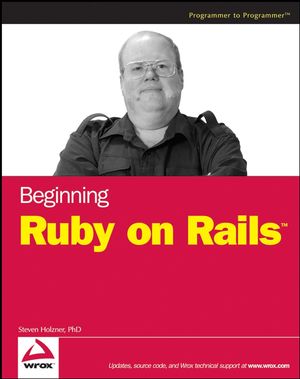Beginning Ruby on RailsISBN: 978-0-470-06915-8
Paperback
408 pages
November 2006
 This title is out-of-print and not currently available for purchase from this site.
|
Introduction.
Chapter 1: Welcome to Ruby.
Creating a First Web Application.
Getting Started with Ruby.
Checking the Ruby Documentation.
Working with Numbers in Ruby.
Working with Strings in Ruby.
Storing Data in Variables.
Creating Constants.
Interpolating Variables in Double-Quoted Strings.
Reading Text on the Command Line.
Creating Symbols in Ruby.
Working with Operators.
Handling Operator Precedence.
Working with Arrays.
Using Two Array Indices.
Working with Hashes.
Working with Ranges.
Chapter 2: Conditionals, Loops, Methods, and Blocks.
It’s All about Making Choices: the if Statement.
Using the case Statement.
Using Loops.
Creating and Calling a Method.
Making Use of Scope.
Working with Blocks.
Chapter 3: Classes and Objects.
All about Encapsulation.
Creating a Class.
Creating an Object.
Basing One Class on Another.
Understanding Ruby’s Object Access.
Overriding Methods.
Creating Class Variables.
Creating Class Methods.
Creating Modules.
Creating Mixins.
Chapter 4: Welcome to Rails.
Putting Ruby on Rails.
Introducing Model-View-Controller Architecture.
Giving the View Something to Do.
Mixing Ruby Code and HTML Inside the View.
Passing Data from an Action to a View.
Escaping Sensitive Text.
Adding a Second Action.
Chapter 5: Building Simple Rails Applications.
Accessing Data the User Provides.
Using Rails Shortcuts for HTML Controls.
Working with Models.
Tying Controls to Models.
Initializing Data in Controls.
Storing Data in Sessions.
Chapter 6: Connecting to Databases.
Tutorial on Databases.
Creating a Data-Aware Rails Application.
Creating the Database.
Running the store Application.
Adding Another Record.
Beautifying the Display.
Chapter 7: Working with Databases.
Displaying Items to the Customer.
Creating a Shopping Cart.
Combining Purchases in the Cart.
Clearing the Cart.
Letting the User View the Cart Anytime.
Chapter 8: Validating and Testing.
Validating the Presence of Data.
Validating if Data Is Numeric.
Validating if Data Is Unique.
Creating the Validator Application.
Writing Your Own Validate Method.
Testing Your Model.
Testing Your Controller.
Chapter 9: Controlling the Action with the Action Controller.
Routing Refinements.
Creating Cookies.
Creating a Filter.
Logging in with Filters.
Using After Filters.
Rendering Text Directly.
Caching.
Chapter 10: Getting the Big Picture with Views.
Creating XML.
Creating XML Attributes.
Using View Helpers.
Using View Pagination.
Using Partial Templates.
Passing Data to Partial Templates.
Chapter 11: Ajax and Rails.
Using Ajax.
Getting Access to Ajax Data.
Using XML and Ajax.
Using HTML Controls and Ajax.
Performing Ajax Searches.
Performing Visual Effects.
Appendix A: Answers to Exercises.
Index.



